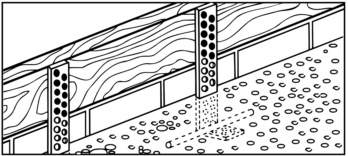L-shaped concrete flat steel anchor
For detailed information, other images and documents, please select individual articles from the following table.
L-shaped concrete flat steel anchor
Concrete flat steel anchors are ideal for use in timber construction for the simple and secure tensile connection of columns, posts and sleepers, whereby the tension tie is firmly embedded in the concrete base material
Exclusively for trade customers
Register now and access more than 125,000 products

Variants
Exclusively for trade customers
Register now and access more than 125,000 products
- Versatile applications for simple tensile connections
- Easy height adjustment on uneven substrates
- Sheet metal hot-dip galvanised on both sides (S250GD + Z275 (approx. 20 µm)), thickness 4 mm in line with EN 10346:2009
- Application in utilisation classes 1 and 2 in line with EN 1995:2013
Proof of Performance
European Technical Approval ETA 14/0274
Notice
- Torsion-free load application is assumed.
- The holes should be nailed starting from the end of the flat steel concrete anchor.
- At least 4 nails should be used and the amount is based on the static calculation. The nails used must have a diameter that fits the holes in the flat steel concrete anchor.
- Live edges are not permitted; the entire surface of the flat steel concrete anchor must lie against the wood.
- The components must be thicker than the penetration depth of the nails.
- The respective basic conditions of the applicable anchor approval must be observed
- Steel failure under bending stress is decisive for flat steel concrete anchors that are fastened in concrete using 43 mm x 4 mm metal anchors and washers in accordance with EN ISO 7094.
- Steel failure under tensile stress is decisive for embedded flat steel concrete anchors.
Instructions


| Notes: |
| Ring-shank nails 4x40 mm must be used for securing in accordance with EN 14592. No specified nail pattern needs to be observed with regard to the nailing method according to ETA 08/0259. Partial nailing is permitted. The specified load-bearing capacities are for softwood with a characteristic density of rk ≥ 350 kg/m³. Design value of the load-bearing capacity of a nail: FVM,Rd = kmod/gM × F1,Rk with gM = 1.3 Design value of the steel load-bearing capacity for anchor mounting in concrete: Fm,Rd = Fm,Rk/gM0 with gM0 = 1.0 Design value of the steel load-bearing capacity for tension anchors in concrete: Ft,Rd = Ft,Rk/gM2 with gM2 = 1.25 Design value of the total load-bearing capacity for anchor mounting: F1,Rd = min {n × FVM,Rd; Fm,Rd} with n = number of nails Design value of the total load-bearing capacity for tension anchors in concrete: F1,Rd = min {n × FVM,Rd; Ft,Rd} with n = number of nails The minimum distances for nails for sheet steel-wood connections in accordance with EN 1995-1-1 must be observed. |
Application area
Embeddable, height-adjustable tension tie connection for connecting wall elements or posts in concrete base materials.
Instructions
Suitable fasteners:
- Comb/ribbed nail in line with EN 14592: 4.0 x ≥ 30 mm.
- Recommended dowels for anchoring in concrete: W-BS; W-FAZ; W-VIZ; WIT-VM 250
Select RAL-colour code
!! NOTE: On-screen visualisation of the colour differs from real colour shade!!







